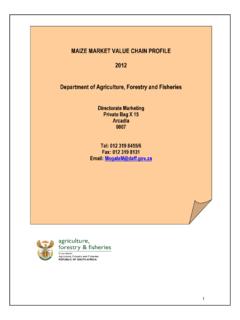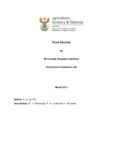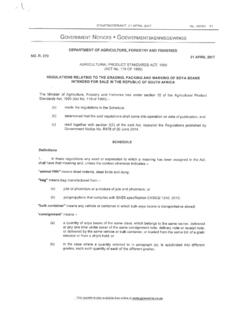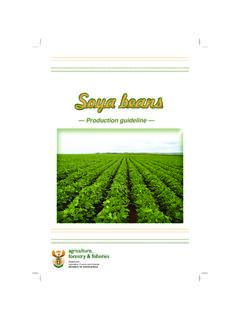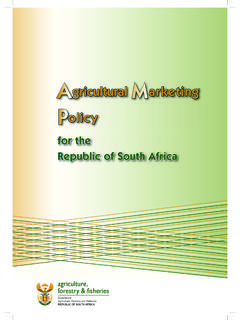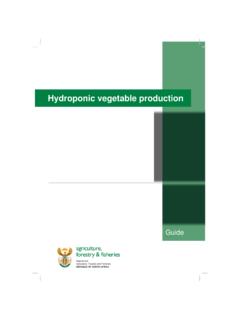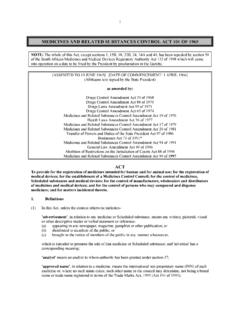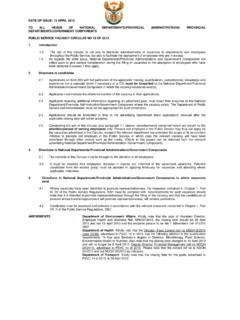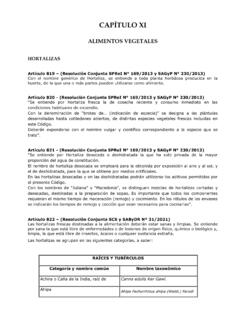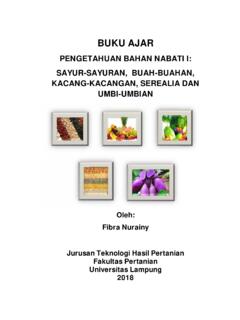Transcription of Squash production guideline - nda.agric.za
1 Agriculture,forestry & fisheriesDepartment:Agriculture, Forestry and FisheriesREPUBLIC OF SOUTH AFRICAG uideSquash ( cucurbita moschata) productionBiDirectorate: Plant ProductionDEPARTMENT OF AGRICULTURE, FORESTRY AND FISHERIESS quash ( cucurbita moschata) production2011 Printed and published by Department of Agriculture, Forestry and FisheriesDesign and layout by Communication Services Private Bag X144, Pretoria 0001 DISCLAIMER This document has been compiled by the Department of Agriculture, Forestry and Fisheries and every effort has been made to ensure the accuracy and thoroughness of the information contained herein.
2 The department cannot, however, be held responsible for any errors, omissions or inaccuracies in such information and data, whether inadvertent or otherwise. The Department of Agriculture, Forestry and Fisheries, therefore, accepts no liability that can be incurred resulting from the use of this 1: General aspects1. Classifi cation 12. Origin and distribution 13. Major production areas in South Africa 14. Description of the plant 25. Cultivars 36. Climatic requirements 47. Soil requirements 5 Part 2: Cultivation practices1. Propagation 62.
3 Soil preparation 63. Planting 64. Fertilisation 75. Irrigation 86. Weed control 87. Pest control 98. Disease control 119. Other cultivations practices 1510. Harvesting 16 Part 3: Post-harvest handling1. Sorting and grading 182. Packaging 183. Storage 184. Market preparation 19 Part 4: production schedule 19 Part 5: Utilisation and nutritional value 21 Part 6: References 221 PART 1.
4 General aspectsThe taxonomy of the Cucurbit family varies with three different cucurbit species, namely cucurbita maxima, commonly known as pumpkins, cucurbita pepo , known as squashes and cucurbita moschata which comprise butternut or kalabasa is a viny, creeping and trailing crop producing fruit and consid-ered to be one of the most delicious vegetables. It is the most commonly and regu-larly grown among the cucurbits because it is a rich source of vitamin A, phosphorus and calcium. The young and tender shoots make good vegetable CLASSIFICATIONS cientifi c name: cucurbita moschataCommon names: English common names include winter Squash , zucchini, but-ternut, pumpkin, gourd, cushaw and African common names: leputshe (Setswana), botterskorsie (Afrikaans),Family name: Cucurbitaceae2.
5 ORIGIN AND DISTRIBUTIONC ucurbita were originally domesticated in Mexico, South America, and the eastern C. maxima and especially C. fi cifolia are more cold tolerant than the other spe-cies and are thought to have been domesticated in the tropical highlands of North and South MAJOR production AREAS IN SOUTH AFRICAB utternut (Cucurbit moschata) is an important summer crop grown by smallholder irrigation farmers in South Africa and is a type of winter Squash . Butternut squashes are increasing in popularity because production and keeping quality are good and sunburn is not a major problem.
6 The harvested fruit is hardy and can be left on the land for a month or has a sweet, nutty taste similar to that of a pumpkin. It has yellow skin and orange fl eshy pulp. When ripe, it turns increasingly deep orange, and becomes sweeter and richer. It grows on a South AfricaSquash is mainly grown in the Mpumalanga Highveld, Mpumalanga Lowveld, and Gauteng (in the Vaal region). 24. DESCRIPTION OF THE BotanySquash is a tender tendril-bearing and viny-like plant belonging to the family Cucurbitaceae of gourd family. The fruit is large and variable in shape, size, colour and markings with a peduncle that is large, soft and corky on the surface at maturity.
7 RootsRooting commonly occurs at the stem nodes, which may improve plant vigour. Adventitious roots are also commonly formed at its nodes. StemIt has a very course, prostrate or climbing annual, herbaceous vine, reaching a length of 4 m or more and fl owering throughout the year. Some varieties produce tendrils that help secure vines, limit wind damage and improve vine growth across weedy and uneven ground. LeavesThe leaves are broadly rounded and heart shaped. The leaf occurring at the node where a fruit is developing is called the feeder leaf because photosynthates from the leaf are preferentially translocated to the adjacent fruit.
8 If present, tendrils indicate ripeness in mature squashes when they begin to brown. FlowersFlowers are erect, lemon yellow to deep orange in colour, about 12 cm long, the male fl owers with longer peduncles than the female ones 15 to 30 cm in diameter. Flowers are generally large with separate male and female fl owers borne on the same plant (monoecious). Male fl owers form fi SeedsSeeds are large (up to 3 cm long). Numerous seeds are embedded in the tissue of the placenta which lies at the centre of the Fruit shapeFruit varies in shape (fl attened, elongated, smooth, and ribbed) and size (0,25 to 6 kg or more).
9 After pollination, fruit develops from the preformed ovary at the base of female fl owers. The shape of the ovary prior to pollination is indicative of the mature fruit shape. 35. CULTIVARST here are several types of winter Squash based primarily on fruit shape and texture. Acorn Acorn squashes are deeply ridged and tapered at one end. They have a dark green rind and a fi rm yellow fl esh. They weigh between 0,45 kg and 1,4 kg. Both bush and vining types are available. Butternut and Waltham butternut these have cylindrical fruit that often bulges around the seed cavity.
10 They have light tan rinds with orange fl esh and are vining in growth habit. Buttercup and Turk s Turban these turban-shaped squashes have rinds that can be multicoloured with green, orange, or grey stripes. The fl esh is medium orange. Spaghetti Squash this Squash is also called vegetable spaghetti. The cylindrical (20 to 23 cm long) fruit has a yellow fl esh that is stringy. Hubbard these are round in general shape but taper to a point at the blossom end. The rind is rough bluish-grey to green with occasional grey stripes. The fl esh is orange-yellow in cucurbita genusCucurbita pepo * (variety melopepo) cucurbita pepo (variety pepo ) cucurbita maximaCucurbita moschataCucurbita argyosperma*Zucchini (summer variety)Acorn Squash (winter variety)Buttercup Squash (winter variety)Butternut Squash (winter va-riety)Cushaw Squash (summer variety)Yellow crooknook Squash (summer variety)Delicata Squash (winter variety)Hubbard Squash (winter variety)Winter crookneck squashCushaw squashScallop Squash (summer variety)Spaghetti Squash (winter variety)Banana Squash (winter variety)
